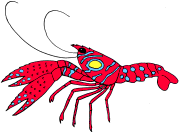
Enoplometopus pictus A. Milne Edwards, 1862
ILLUSTRATIONS. - • Type specimen from La Réunion. After A. Milne-Edwards (1862: pl. 19)..
REFERENCES. - Enoplometopus pictus A. Milne Edwards, 1862a: 362 (Type locality: île Bourbon = Réunion).
Enoplometopus pictus - A. Milne Edwards, 1862b: 15 (Réunion). - Bouvier, 1915: 182 [5] (Differences between E. pictus and E. occidentalis). - Ward, 1942: 61 (Mauritius; "The modern interpretation of this species makes it a synonym of E. occidentalis (Randall) from the Hawaiian Islands, but until I can compare the Mauritian example with one from Hawaii I prefer only to refer to A. Milne Edward's original description and figure"). - Holthuis, 1946: 79 ("The type specimen described by A. Milne Edwards is preserved in the Paris museum and at present is the only one known to belong to this species, all other specimens described as E. pictus belong to E. occidentalis"). - de Saint Laurent, 1988: 61 (List). - Chan & Yu, 1998: 190 (Key).
Not Enoplometopus pictus. - Miers, 1880: 380 [= Enoplometopus occidentalis (Randall, 1840)].
Few other references in Holthuis (1946: 79).
LOCATION OF TYPES SPECIMENS. - Muséum national d'Histoire naturelle, Paris (MNHN). The holotype and sole known specimen for this species should be in Paris dry collections, registered here as MNHN AS 182. It was however search in vain for that study (December 2001, April 2002).
MATERIAL EXAMINED. - None. Data from literature.
CARAPACE. - Lateral edge of rostrum with four spines, or five spines (type specimen with 5 spines on left, 4 on right). Carapace armed with five median spines (according to A. Milne Edwards, 1862, pl. 19); no postcervical spine or an indistinct one; three lateral spines; two intermediate spines; one supra-ocular spine.
CHELIPEDS (P1) & AMBULATORY LEGS (P2 to P5). - Chela broad and compressed, about 3 times as long as wide; dactyl of cheliped with spines and tubercles on outer margin; spines disposed over the full length; upper and lower faces of chela with tubercles (with a rather distinct median longitudinal row). Dactyl of second pereiopod short less than 0.3 times as long as propodus (0.275 on A. Milne Edwards drawings); carpus without distoventral spine (to be confirmed).
ABDOMEN & TELSON. - Pleurae of abdominal somites II to V rounded or bluntly pointed. Anteroventral margins of pleurae II to V smooth (to be confirmed). Posterior margin of sixth abdominal tergite smooth or tuberculated, but without true spines. Male first pleopod unknown. Telson with one lateral spine (to be confirmed); and three distolateral spines (to be confirmed).
COLORATION. - Ground color of body purplish (with tip of tailfan bluish). Lateral face of carapace with large rounded patch on gastric area (to be confirmed; Bouvier, 1915: 6 "...une paire de grosses taches arrondies sur les côtés de l'aire gastrique ..."). Ambulatory legs almost uniformely colored (according to A. Milne Edwards, 1862, pl. 19). Abdomen with several ocellated spots (white spots circled with blue according to A. Milne Edwards, 1862: 15 "... taches blanches cerclées de bleu ...").
DISTRIBUTION. - West Indian Ocean: Réunion and perhaps Mauritius. Deep distribution: not known.
REMARKS. - Enoplometopus pictus is a large species (130 mm) still known only by its holotype. Its status remains unclear: several authors (Ortmann, Rathbun, ...) synonymized it with E. occidentalis (Randall, 1840) but Bouvier (1915) indicated that the two species are distinct. The most decisive character used by Bouvier is the ground color of the body: bluish in pictus, orange in occidentalis. Also, white ocellated spots of the abdomen are circled with blue in pictus, and with orange in occidentalis.
Cite this publication as: Joseph POUPIN (2002 onwards).Tropical reef lobsters of the genus Enoplometopus: Descriptions, Illustrations, Identification, and Information Retrieval, using the DELTA format. Version: 30 May 2002. At http://biomar.free.fr/enoplometopus/.